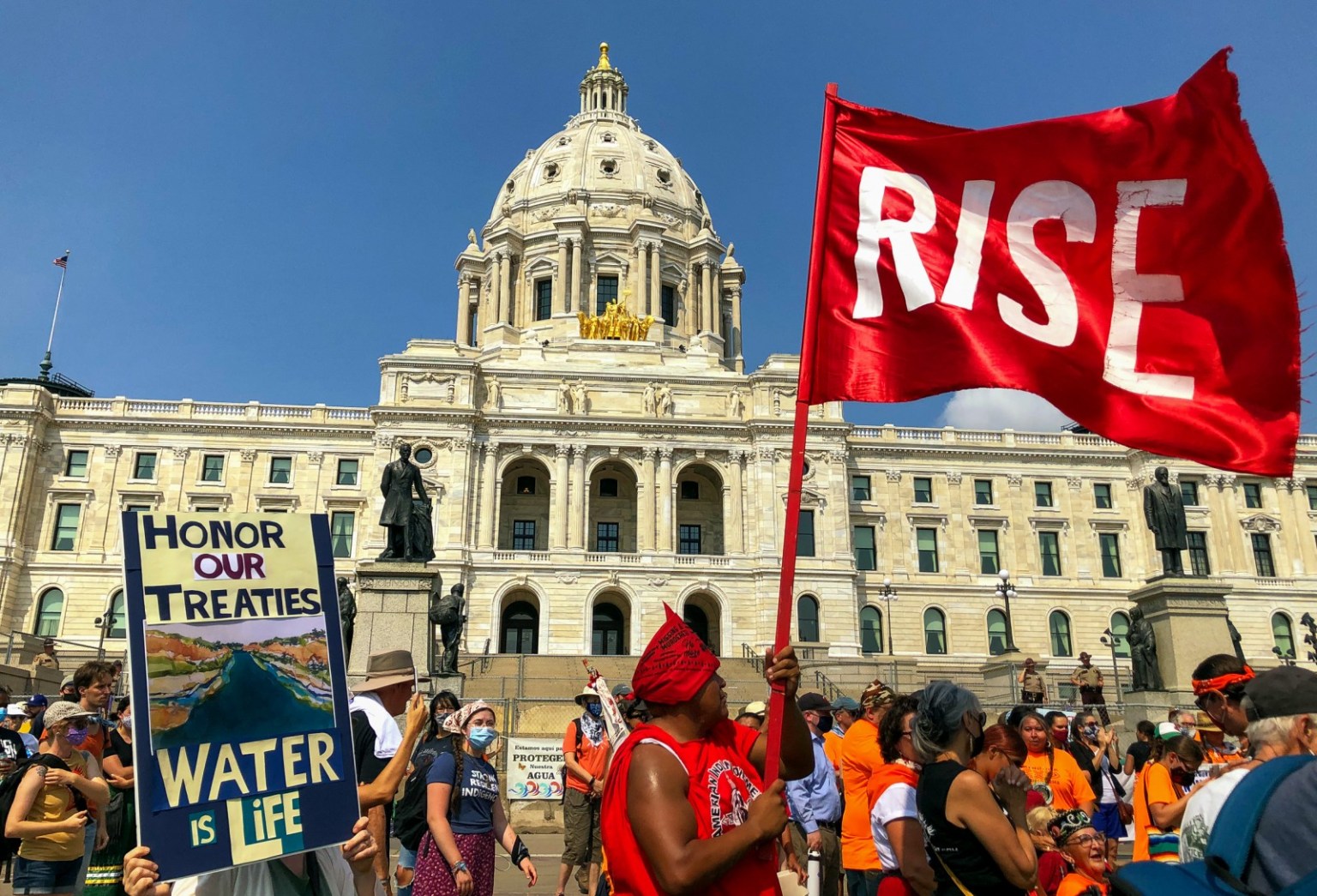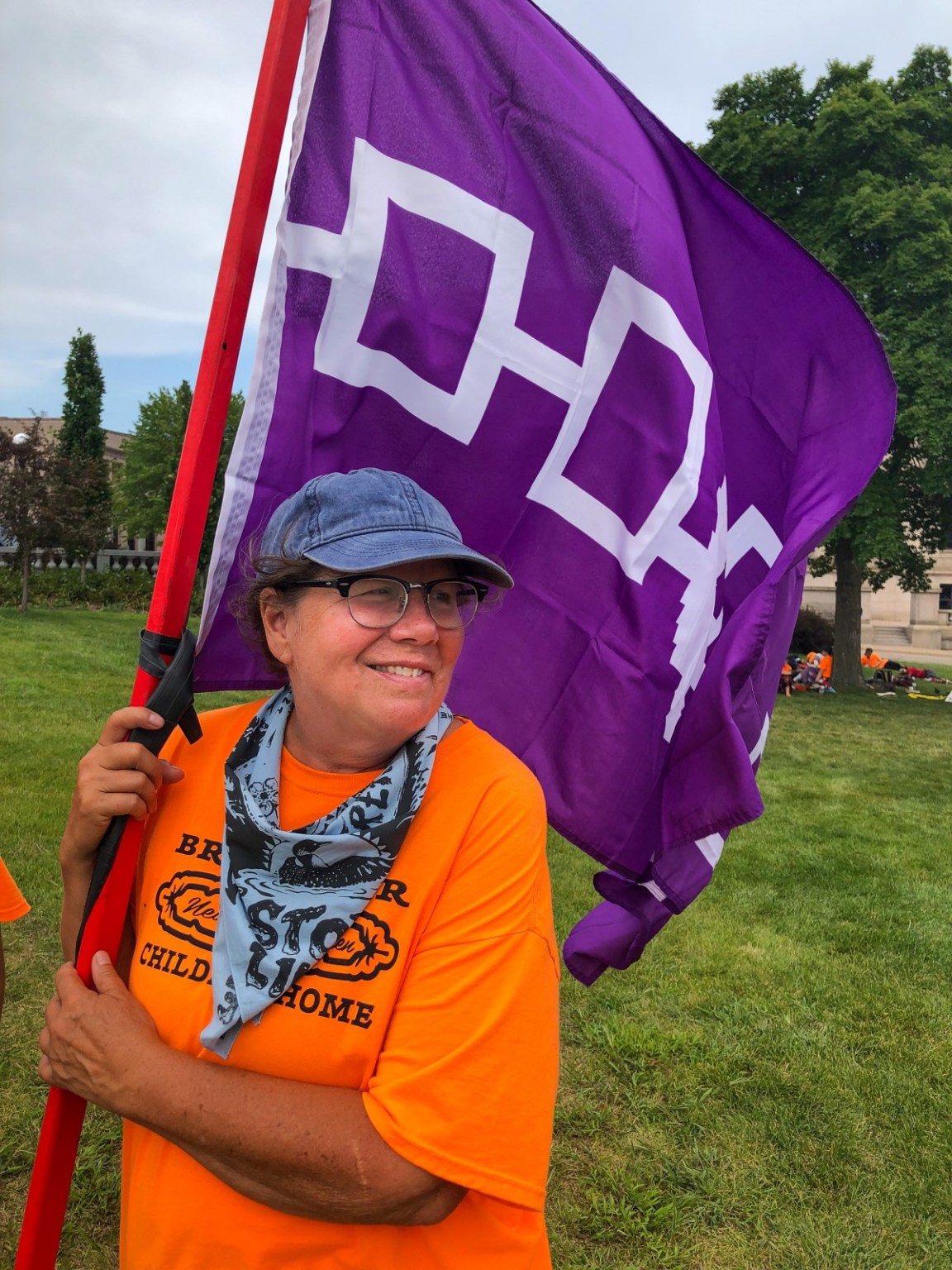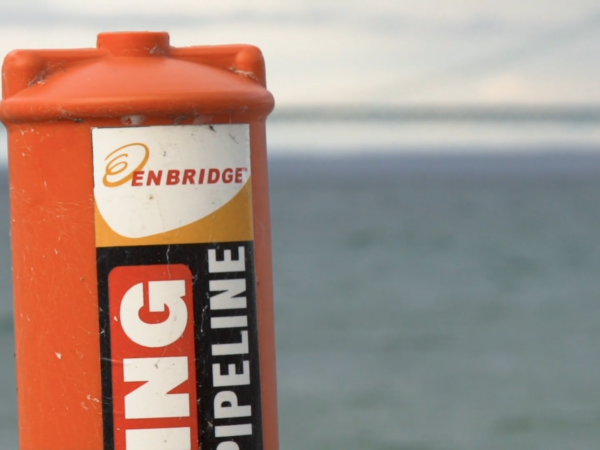
By Laura Gersony, Circle of Blue
The Great Lakes News Collaborative includes Bridge Michigan; Circle of Blue; Great Lakes Now at Detroit Public Television; and Michigan Radio, Michigan’s NPR News Leader; who work together to bring audiences news and information about the impact of climate change, pollution, and aging infrastructure on the Great Lakes and drinking water. This independent journalism is supported by the Charles Stewart Mott Foundation. Find all the work HERE.
Carrie Huff Chesnik, an Oneida tribal elder, clutched a Mason jar to her chest on the last leg of a 250-mile protest walk from northern Minnesota to the State Capitol. She spoke about the jar, filled from the headwaters of the Mississippi River near where Indigenous tribes are mounting fierce opposition to the Line 3 oil pipeline, as if it were a dear friend.
“She has come a little bit out of the water flow, and spent these days on this walk with us,” she said. “She’s watched it all, seen it all.”
“Here,” she said in the next moment, handing it to me, “you give it some love.”
Protests come in all sizes and iterations. The odyssey of the Mason jar follows years of Indigenous-led activism meant to elevate to public attention the ecological and cultural risks of the Line 3 oil pipeline and, ultimately, halt its construction.
Tribal leaders assert that the nearly completed 36-inch pipeline, which stretches 330 miles across northern Minnesota, will damage streams, lakes, and beds of wild rice they hold sacred. State authorities and Enbridge Energy, its developer, say the new line, which replaces a smaller, existing segment of pipeline, is safe.
In its basic outlines, the Line 3 dispute adheres to much the same contours of citizen concerns about water and climate change, and developers’ dismissals of both, that have defined other battles to shut down new fossil fuel pipelines in the nation. In Minnesota, opponents cite a host of factors, including its potential violations of native treaty rights, the need to rapidly phase out fossil fuels to combat climate change, pipeline construction workers’ sexual violence against Indigenous women, and one more: disagreement over water science and hydrology.

Carrie Huff Chesnik, a member of the Oneida Nation in Wisconsin, said that the fight over Line 3 epitomizes the contradictions between indigenous and settler views of nature. “We are slowly killing the mother.” (Photo Credit: Laura Gersony/Circle of Blue)
But this is the summer when extreme heat, epic drought, and severe water scarcity — the products of climate change — converged to produce a water emergency in the West and upper Great Plains. Crops are dying. Livestock are being culled. Communities are running out of water. Climate change and its source in fossil fuel production, transport, and combustion have added greater visibility to the clash over Line 3. Opponents, among them the author and activist Bill McKibben, are calling on President Biden to intervene and cancel Line 3. “At this point, approving Line 3 would be absurd,” McKibben wrote in a recent op-ed.
Chesnik also fears the worst. Though the jar held an infinitesimal fraction of the Mississippi River waters it was drawn from, in it swirled the myriad reasons that animated the elders’ journey: their concern for waterways amid a historic drought; their anger after centuries of violence and erasure that threatened their culture; and fear that as government agencies insist on the pipeline’s safety, they will once again be left unheard.
Asked what the water means to her, Chesnik replied holding back tears. “It’s too precious. We have to make sure the water is protected.”
Construction Risks of the Pipeline
Enbridge is constructing the new pipeline to replace an aging segment of the original Line 3, built in the 1960s, in hopes of doubling its transport capacity to 760,000 barrels per day. Among the latest sources of controversy is a state permit that Enbridge was granted three months ago. Portions of the pipeline’s new route run through pockets of land saturated with groundwater. Enbridge needed to get a permit from the state’s Department of Natural Resources to pump water out of the construction trench. In December, Enbridge was granted permission to pump 500 million gallons of water—not an unusual quantity.
But in January, soon after starting construction, Enbridge asked for permission to pump ten times as much water. They chalked the disparity up to two factors. The first was the unusually warm winter, which made the ground wetter than usual. The second was to pursue a more water-intensive pumping strategy aimed at curbing the discharge of muddy water. According to DNR data, it amounted to one of the largest appropriations requests for shallow aquifers in the state’s history.
The DNR didn’t inform tribal leaders of the request until mid-May, nearly six months after it was received. The agency held a conference call to discuss tribal leaders’ concerns on May 27, and issued the permit just one week later.
The DNR has defended the permit on the grounds that the removal of water is “temporary,” since it must be put back into the environment within three days. The agency maintains that the operation will not have a lasting effect on nearby water resources.
Additionally, with the majority of the pipeline’s construction completed, Enbridge has only pumped around 800 million gallons, saying that dry conditions reduced the need to dewater. “DNR has seen these low water conditions across the state; they are not exclusively or disproportionately associated with the geography of the Line 3 replacement,” wrote Gail Nosek, a DNR spokesperson, in an email to Circle of Blue.
“The assertion that the temporary act of trench dewatering has exacerbated the drought is theoretical and unsubstantiated,” Nosek added.
But the process enraged tribal leaders and many scientists, who have long decried the project as evidence of “regulatory capture”: when agencies operate in deference to private companies, rather than in the public interest.
Frank Bibeau, a tribal attorney, argued that the DNR’s outreach when issuing the permit did not constitute “meaningful consultation” with their governments, which is required under an executive order signed last year by Minnesota Gov. Tim Walz when state agencies make a decision that will affect Indigenous nations. The tribes only learned that the permit was approved when a member followed up with the agency the following week.
Bibeau has filed a lawsuit against the DNR to appeal the groundwater appropriations permit. The lead plaintiff in the case is manoomin: wild rice.
The suit builds off of a 2018 law, passed by the White Earth Band of Ojibwe, that gave inherent legal rights to wild rice. This was one of the first “rights of nature” laws, a legal theory that nature possesses the right to flourish in and of itself.
Others object to how the permit was revised largely behind closed doors. The DNR concluded that the increased dewatering would not have a significant impact on local waterways, and as such, did not meet the standards for an Environmental Impact Statement—a lengthy process that would have required a public comment period.
Laura Triplett, an environmental geologist who has spoken out against the dewatering permit, said that if the original permit application had come in at 5 billion gallons, she would have raised her eyebrows.
“I would have submitted a comment, and I would have had some questions,” she said. “It destroys the entire point of the public notification period if the agency can just go in and willy-nilly change the numbers afterward.”
The permit has received a litany of objections on scientific grounds. In July, over 40 scientists signed an open letter to Joe Walz, Minnesota’s governor, and President Biden, calling the process “sham permitting” due to the lack of public comment period and because it overlooked several key environmental concerns.
“In our evaluation as scientists, this water appropriation could have substantive negative impacts on sensitive waterways,” they wrote.
The DNR and Enbridge respond that, without exception, challenges to pipeline permits have been upheld in court. State agencies and Enbridge say that the court outcomes are a testament to the pipeline’s safety and the validity of the permitting process.
But there are weaknesses in those formal assertions. Pipeline construction has already produced unlawful pollution. In order to construct the pipeline underneath sensitive bodies of water, such as rivers, it uses a technique known as “horizontal directional drilling.” Using this method, a drill lubricated with drilling mud bores through ground underneath the river.
The Minnesota Pollution Control Agency announced in August that Enbridge caused 28 drilling mud spills, including 13 into a wetland, in violation of a federal environmental permit. Water was polluted in 12 of the 19 waterways.
Darin Broton, an MPCA spokesperson, told Circle of Blue in an email that “the agency is investigating these spills and other possible violations, and hopes to have its work wrapped up this fall.” Penalties for violating the permit, he wrote, “are determined by the magnitude of the violation.”
Scientists are uncertain of the effects of the spills on the environment, since the composition of the drilling mud is a company secret. But Christine Dolph, a water resources scientist from the University of Minnesota, said that drilling mud generally includes fine sediments, which can damage wildlife by lodging in the gills and small organs of fish, insects, and other aquatic life.
The stakes of the debate are high. Minnesota is in the midst of a drought so extreme that, in some regions, the state’s drought monitor cannot list what consequences to expect.
Water scarcity has been brutal for Indigenous wild rice harvesters. Simon Zornes, an Ojibwe artist and farmer, has spent a lifetime cultivating the crop, which grows in lakes across the region. His grandfather taught him the art nearly fifty years ago. Now, he can recognize when the above-water portion of the plant starts to form “brown socks,” the telltale sign that it is ready to be harvested; he knows just how to coax the individual grains out of the long green stalk; and he has started passing along the knowledge to his own grandson, Marcus.
But for the first time in years, Zornes is tarping the cords of lumber he uses to parch rice, and hoping for better luck next fall. His go-to wild rice lakes, usually brimming with chest-high water at this time of year, are too shallow to even float a canoe.
“It’s up in the air if I’ll be able to get out there at all,” he said. “I’m scaling it way back.”
To Zornes, Line 3 is just the latest in a long story of abuse. “They’re taking our water; they’re taking our livelihood,” he said.He views the actions of state environmental agencies as something akin to betrayal, and fears for the future of wild rice. “The DNR was supposed to protect this wildlife. What happened to that?”
“Our culture has been chopped up into little slices,” Zornes said, sadness seeping into his voice for the first time. “We’re fighting on all sides to protect it.”
Discussions of whether Line 3’s construction and dewatering are exacerbating drought conditions are largely speculative, since there’s little publicly available data on the question. But scientists fear that if aquifers dry up, so too will the wetlands, lakes, or other bodies of water that they support.
Many of their concerns revolve around how the displaced water will return below ground, a process known as infiltration. Christine Dolph explained that there is no available evidence to support the DNR’s assumption that the aquifers they extract water from will be recharged.
Reached for more detailed information, the DNR said simply that water is not transported a significant distance from the aquifer from where it came. But Dolph and environmental scientist Laura Triplett believe it’s more complicated than that.
In her 25 years as a researcher, Triplett knows that it takes years of careful evaluation to determine the water flow patterns in just one small wetland. So the DNR’s confidence that the 300-mile-long construction project will not have a lasting impact on the region’s aquifers and wetlands strains credibility.
“We often talk about this project as ‘death by a thousand cuts,’” said Dolph. “There seems to be a belief by agencies that if you do a little something here, and do something there, the impact won’t be that great. But this project is hundreds of miles long, across a sensitive region of the state that is experiencing increasing risks to water quality from a number of different stressors. You really have to look at the cumulative, big picture.”
Suing On Behalf of Wild Rice
Litigation to overturn the permits continues. One leg of the legal battle is the question of where the case will be heard. The state of Minnesota is pushing for the case to be heard in federal court, while the plaintiffs want it to be heard in tribal court, each hoping for the place that will deliver their favored outcome.
Thomas Linzey, a lawyer who has worked to advance the rights of nature theory, sees this dynamic as crystallizing a deeper, centuries-long fight over Indigenous sovereignty.
“This is not just about wild rice. It’s about sovereignty, power, and treaty jurisdiction, and, for want of a better term, white courts versus the tribal court system,” he said.
But the tribe’s legal team is also hoping to use new legal mechanisms — “rights of nature” — that they say better protect Indigenous rights.
“We know the laws that have been put in place by the state of Minnesota and the federal government aren’t designed to protect tribal interests and rights,” said Bibeau, the tribal attorney. “State laws are made to ultimately permit the activity that applicants are looking for,” even to the detriment of native communities.
The reasoning behind the lawsuit draws on a growing body of theoretical work. Linzey said that the laws aim to counteract the current legal status of nature as just a resource.
“There’s no more embedded tenet in Western, European law than the legal conclusion that nature is property, that ecosystems are property, that land is property. It’s built into our deed and property owning system,” he said. “We need another body of law that supplements and augments our human rights system with one in which nature is the direct litigant.”
This theory more closely matches Ojibwe traditional beliefs, which treat nature as a sacred relative. The belief is intuitive to Carrie Huff Chesnik, who, as we walked towards the State Capitol, explained that Line 3 epitomizes the tension between Indigenous and settler outlooks toward nature.
“All the struggles are about the same thing. How do we conduct ourselves, how do we carry ourselves as we walk through life? Are we in good relationships with everything around us?” she said.
Watching the new pipeline advance across her homeland, and experiencing the natural world weaken around her, has felt like losing a loved one. She’s felt anger, passion, and fear for the future of the land where she grew up. But the main feeling, she said, is sheer grief, resonating from one harrowing truth she and other native peoples have known for ages: “that we are slowly killing the mother.”
Catch more news on Great Lakes Now:
Line 3 opponents descend on Minnesota Capitol to seek a stop
Minnesota Supreme Court delivers blow to Line 3 opponents
Bacteria Cleanup: Should we let nature clean up oil spills?
Featured image: Indigenous leaders performed a 250-mile “Walk for Water” across Minnesota, from the headwaters of the Mississippi to the State Capitol, to oppose the Line 3 pipeline. (Photo Credit: Laura Gersony/Circle of Blue)




